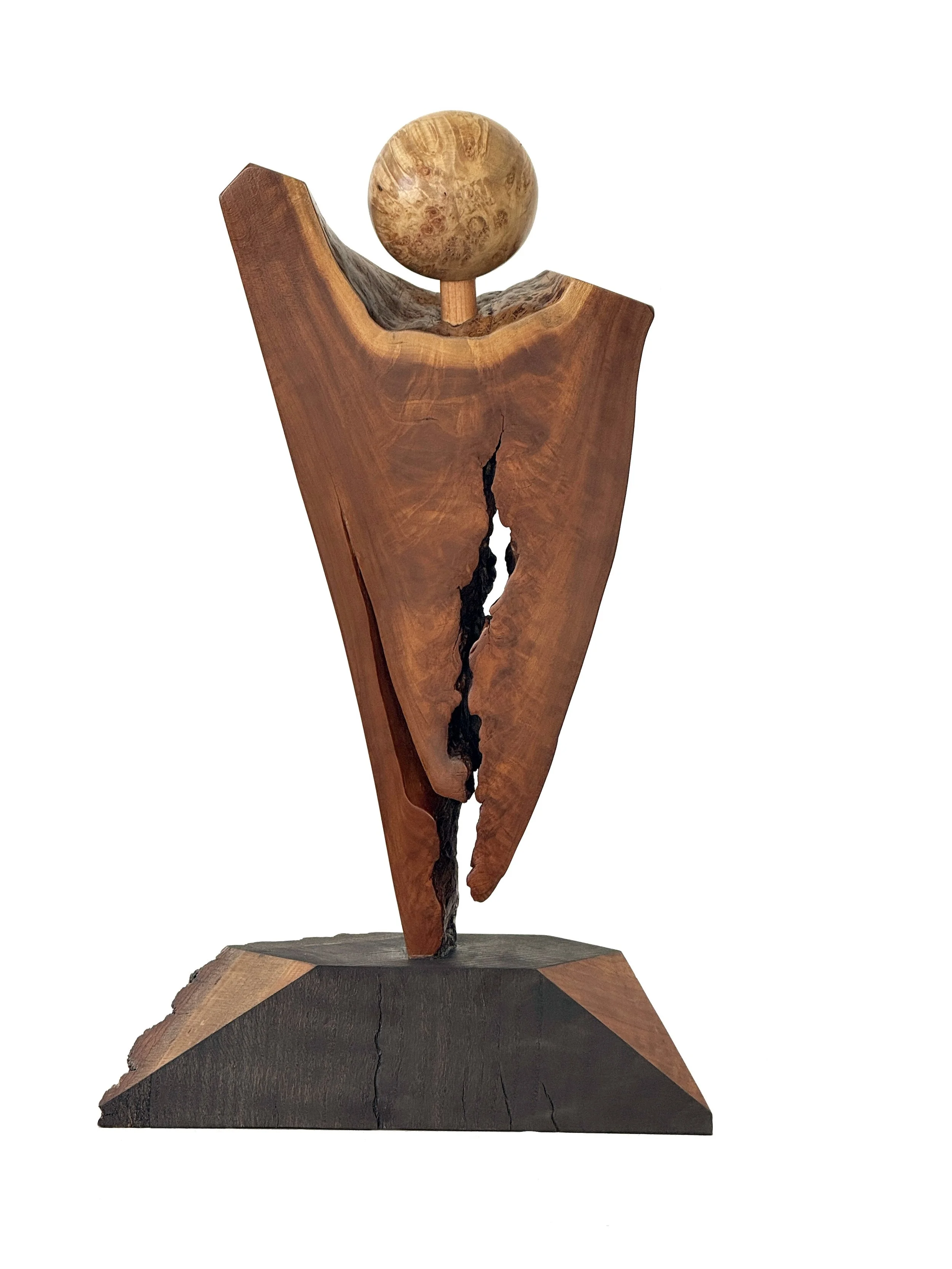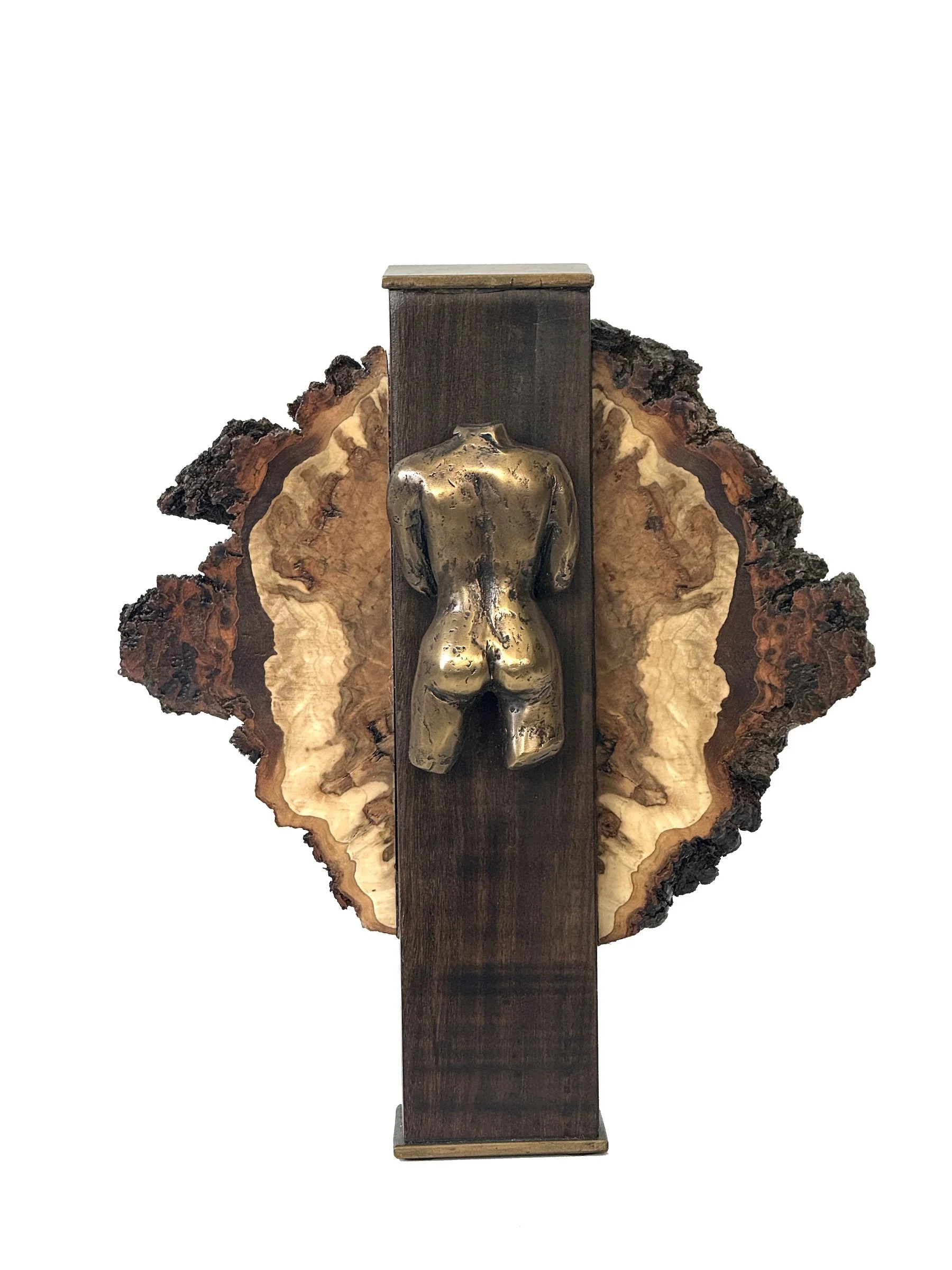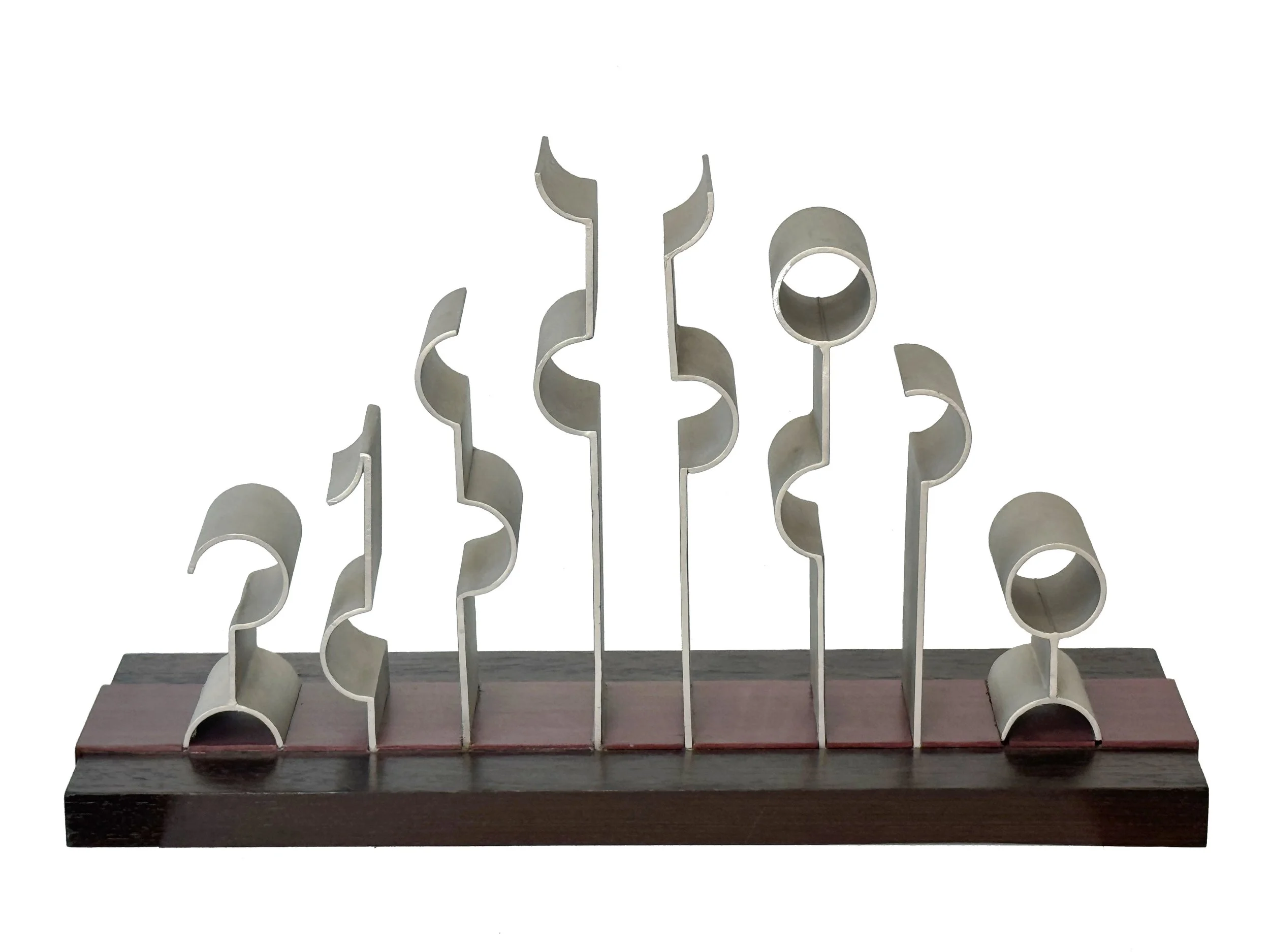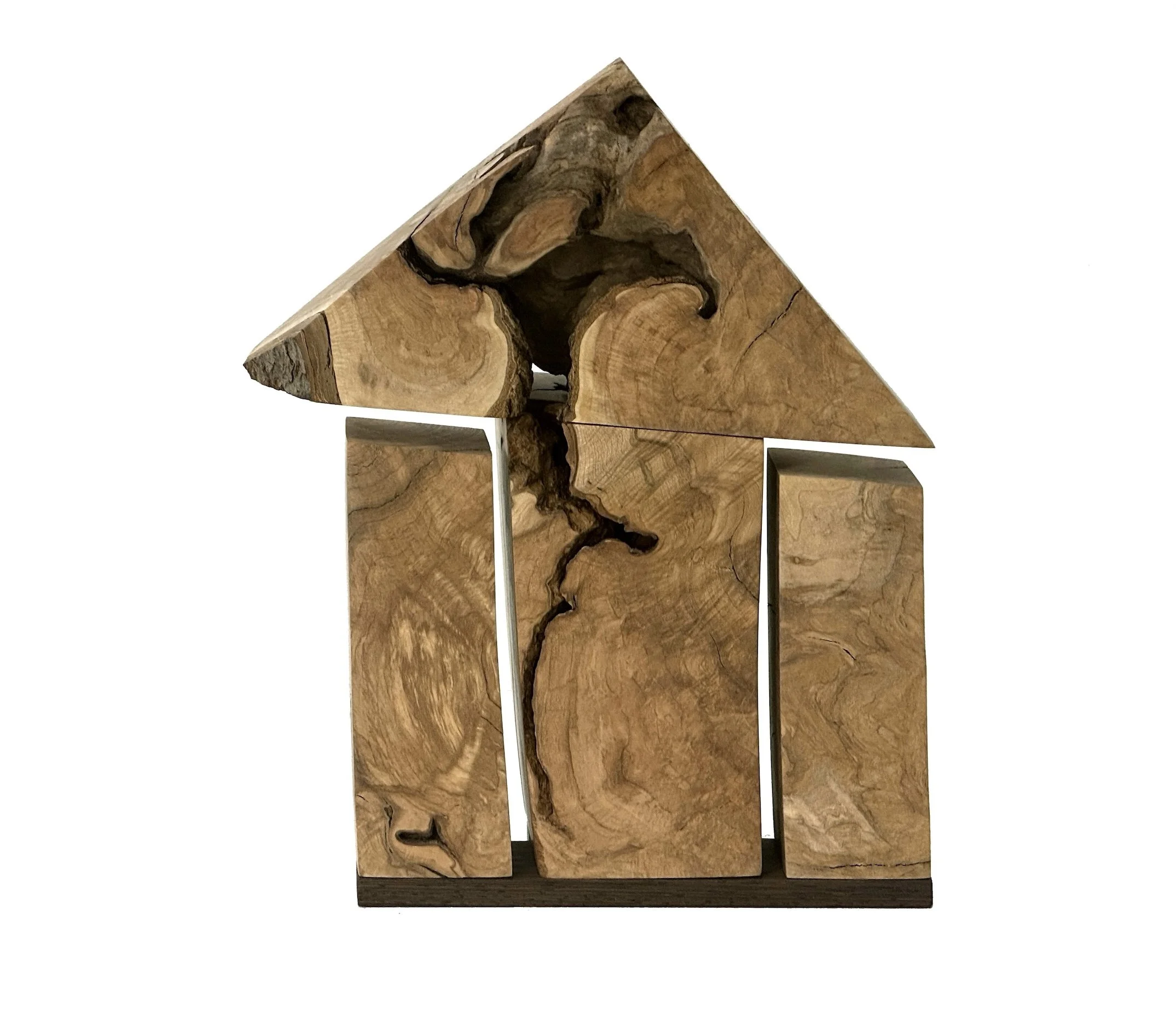Interview with artists Mollie Munro and Tod Switch
Artists Mollie Munro and Tod Switch share the rare joy of finding each other and their shared love of woodworking and sculpting relatively later in life. Mollie worked in a family shoe business and Tod was an architectural photographer. They are now full-time artists creating expressive works in wood, metal and stone, and each permit the material to dictate what they create and give voice to. More of their work can be found at todswitch.com.





AAS: Where did each of you grow up?
TS: I grew up in Milwaukee and then Jackson, Wisconsin. I worked in a rental store throughout high school and 2 years of college (I wanted to be an architect / engineer) but an opportunity came up and I moved to Buckhead in Atlanta, Georgia. In 1985 and started renovating homes. A few years later I met an architectural photographer who was doing work in Atlanta. He needed an assistant and after working with him the first day, I knew this was my calling. After two years of assisting him around the country, he offered me a job in his studio in Little Rock and I moved there in 1991. After a short time, I went out on my own and stayed in Little Rock.
MM: I grew up in Hot Springs, Arkansas but in 10-12th grade I went to boarding schools in Viginia for a year then Concord, Massachusetts for 2 years, then college in Santa Barbara, California.
AAS: Where and how did the two of you meet?
MM: Blind date! Tod was good friends with a fellow professional photographer. His wife did some graphic work for the business where I worked. They set up a ‘meet and greet’ at an art exhibit of the wife’s at the Decorative Arts Museum in Little Rock. I was 45 at the time and never married. At that point, I had given up all expectations of ever doing so, which was fine, because I traveled a great deal for work, going all over the US and many foreign countries, and had the freedom to pursue my interests, art being one. I hated blind dates (at my age, I’d been on plenty) but one can never overlook the possibility of finding a friend. Of course, it was the best blind date of my life, so it just goes to show that we should never give up!
AAS: Tod, when did you decide to become a sculptor full-time?
TS: After 20 some years as a photographer there were a lot of changes in the industry: digital cameras, in-house photographers, etc. and I was getting burned out. After we married, Mollie asked me “If I could do anything and not have to worry about making a living, what would I want to do?” Without hesitation I said, “Go back to school.” So that’s what I did. I started out in the art dept. at UALR in printmaking. It was an easy transition because viewing an image on the ground glass of a 4x5 view camera is reversed left to right and upside down. In direct lithography from a stone or plate the final print will be a mirror image of the original drawing. So I was used to looking at things differently by seeing the artistic composition and not the “normal” image. I also liked the physical aspect of working with my hands. Experimenting with the medium, I started folding up some of my prints, and that’s when I went from a 2-D to 3-D artist. I loved working with metal, wood and stone. And while most sculptors tend to specialize in one material, I liked to use different ones, depending on the piece.
AAS: Mollie, what about you?
MM: In my 30’s I felt like I needed some balance in my life – all I did was work. I also found that most of my friends were busy with spouses and children, so I wanted something to fill up my free time. I’d always loved and collected art (very cheap art because I didn’t have much money back then) and thought it would be fun to try. I took a few classes at the AMFA, but then decided to get serious and enrolled in the art department at UALR. Took all the basic classes, and enjoyed them all, but my talent was limited in the mediums I tried. After Tod and I married, he started taking classes to focus on his artistic goals and encouraged me to take a beginner woodworking class with him. I did NOT want to. I am scared of power tools, or anything with a motor that you can’t drive with a steering wheel. I found though that the sheer beauty of wood and the possibilities it offered me outweighed my reluctance. I am still not confident around machinery – things can go sideways in a nanosecond – but I can get the job done, though I confess Tod does the more challenging machine tasks for me.
AAS: Tod, I want to ask you first about On The Half Shell. I really love it!. Tell me about your choice of woods and the techniques you used.
On The Half Shell, ailanthus, spalted hackberry, 9.5”H x 20”W x 10”D
TS: As part of a continuing education series at UALR artist Hunt Clark came in to demonstrate his technique of power wood carving using a chain saw. I started my piece with a 4’ tree trunk and carved a shape into the log. Then cut around that shape leaving about an inch thick vessel. With other sanders and grinders, I took the thickness down to where I wanted it. The wood was from an ailanthus tree, which I was unfamiliar with. I enjoy working with different species of wood and learning their characteristics. It sat for a few years as a vessel, and I wasn’t inspired enough to finish it until I found a new piece of spalted wood (ball) that matched the vessel. Now it transitioned from a simple bowl to a special piece of art.
AAS: Tod, where did you learn to incorporate metal into your wood sculptures? Vestige is a terrific example of your ability merge the two media into something where they belong together.
Vestige, cherry, red oak, steel, stone, 17”H x 11.5”W x 5”D
TS: The simple answer is that I had to master many materials and techniques to keep up with my progression as an artist. After seeing some artists outsourcing portions of their pieces, or even entire sculptures, I was determined to learn how to do everything possible myself. To that end I have taken classes in woodworking and finishing, small-metals (jewelry), bronze casting, welding, forging, furniture design, stone carving, glass slumping, etc.
One of my favorite educational experiences was a three-week course at Penland School of Craft. I had never been at such a level of artistic immersion, and my brain exploded! It is where I started my Keyhole series, which turned into over 50 sculptures. I made Vestige by fabricating a steel base to provide the foundation for the cherry bricks on top. This wood was very special to me, having been harvested from my family’s land years ago. I wanted to create a grand gate, and called it Brick de Triomphe. But like On the Half Shell, it sat for a while because I knew it could be better. When I cut out one top “brick” and added a live edge piece and then added a stone that I got from my travels to Africa (Mollie and I got married on the top of Mt Kilimanjaro) it all came together as Vestige – which I think is much stronger.
AAS: Diamond in the Rough is an extraordinary piece. It must have been very labor intensive but fun to create. Tell me about it.
Diamond in the Rough, maple, basswood, stainless steel, 9”H x 12”W x 12”D
TS: It started as a maquette for a large outdoor public art submittal. My proposal was a 30’ tall stainless-steel diamond supported in the V truss of the Junction Bridge over the Arkansas River in downtown Little Rock. I refined the diamond shape by making multiple versions in Illustrator and then laser cut it in wood. When I finally got what I wanted I had some stainless-steel water jetted for the precision cuts – fabricating such an intricate pattern in metal was over my skill set - then welded it up. It was such a dynamic model that I knew it needed to become a standalone sculpture. I laser cut some wood and dried it in a kiln, reducing the moisture content, then inserted the wood at normal humidity so it would swell to form a tight fit. Put on some finish and put it on the shelf. A few years later I bought a load of burl castoffs from a wood turner in Wisconsin and found a piece that immediately brought the diamond to mind. I couldn’t have designed a better piece of wood to anchor, contrast, and compliment the diamond, and once it was set into the burl, Diamond in the Rough became one of my favorite sculptures.
AAS: You were an architectural photographer for so many years where you had to decide how best to capture a 3D “sculpture” in 2D. Now you are creating in 3D. Did you have to retrain your artistic eye or do a hard reboot of your creative brain?
TS: It came naturally because they are both about light, and how that shows form. In photography you anticipate what the light will do and when, capturing it at the precise, special moment where 2D looks 3D. When thinking about a sculpture, a material’s detail catches my eye, whether it’s a pattern, texture, shape, or feeling, I know I can enhance that in fabrication and finish that will highlight its inherent beauty.
AAS: Mollie, where do you get most of your inspiration for your sculptures?
MM: Life. I don’t really do artwork just to create something visual. I do a piece of art when I have something to say, and once I’ve said it, I move on, because I don’t want to repeat myself. The sentiment is the driving force, but sometimes the wood reveals the sentiment, and that’s where the real magic happens for me.
AAS: Was Another Roadside Temple inspired by your travels?
Another Roadside Temple, holly, bloodwood, wenge, and jadeite, 16.5”H x 18.5”W x 25.25”D
MM: Yes. Spent time in China and India for work, and I loved the roadside altars you see everywhere over there. I would sometimes stop, and while I didn’t understand the purpose, I could share paying homage to beliefs. I also spent years driving all over the US, where you often see memorials to those killed in auto accidents. Temple has an Asian aesthetic, but it’s cobbled together and looks more like an American fast-food drive through. People have been building places to worship since our development as homo sapiens, maybe even before, so Temple is my universal ‘church’.
AAS: Geo Earth is an outstanding composition. Did it come to you when you saw the wood or were you looking for just the right wood to create it?
Geo Earth, maple burl, 8.25”H x 18.5”W x 3”D
MM: All three in the Earth series were totally inspired by the wood, which is burl. This is one of those instances where the wood showed me what it wanted to say – I just refined it for viewing. Burls are amazing because they are incredibly complex and beautiful, yet are a tree’s response to invasion/infection/trauma. When I started cleaning up the pieces of burl that Tod bought home from Wisconsin, it was like looking at a painting – the burl was a picture of the earth that nurtured the tree, so Geo Earth is the micro material revealing the macro environment that created it. There’s no finish on these pieces because the earth doesn’t need such artificial enhancement – the geological processes that create the incredible landscapes of earth are sufficient - so the pieces are sanded to 500 grit to recreate the polishing action of erosion.
Belladonna, bloodwood, holly, and wenge, 11”H x 11”W x 12”D
AAS: I think my favorite of yours is Belladonna. As a retired pharmacologist and toxicologist, I love your interpretation of the delicate yet toxic flower – giving it the strength and fierceness it deserves.
MM: Exactly! In nature it’s a flower that hides its power behind innocuous leaves and petals and I wanted to show the beauty of that deadly secret. It’s also a metaphor for people, who may look weak but do have defensive weapons, and while those might not be as deadly as belladonna’s, they should not be underestimated.
“Our art explores the aesthetic potential of various materials, and the inherent qualities of these materials drive our creative process.”
AAS: Creating these elaborate objects of out wood and metal must require a well-equipped workshop. Where is your workspace, and where do you get your materials?
TS: We now have a 2,500 sq ft studio/shop next to our home in West Little Rock on eight acres along the Arkansas River. It is the ideal setting to live and be creative. We find our materials on our travels around the county, and by friends who are always on the look out for us, and by harvesting and finding materials on our own land.
AAS: Tod, I know your work has been in many exhibitions over the years. Have the two of you ever exhibited together? Do you have upcoming plans to do so? And where can readers find your sculptures?
TS: In the past we have had only one joint exhibit in 2013, the Thea Arts Festival where we won Best in Show. We will also be at this years AMFA Art Market coming up the weekend of Sept 5-7, which will be our only show this year.
Our art explores the aesthetic potential of various materials, and the inherent qualities of these materials drive our creative process. We feel that by working together, and not just offering each other our advice, our work is stronger and we will be working this way from now on. This past year we have been making art and furniture for ourselves and family members and doing commissioned work. We will be opening our studio once a year for a show and sale and be available for private viewings upon request.






